Strategic Planning for Tourism and Leisure: A Hong Kong Case
VerifiedAdded on 2023/06/13
|24
|6645
|358
Report
AI Summary
This report provides an overview of strategic planning for tourism and leisure in Hong Kong, highlighting the role of the Hong Kong Tourism Commission and its partnerships with various stakeholders. It appraises the impact of the Tourism Commission's work on tourism, leisure, events, and hospitality, discussing both the benefits and challenges. The report also examines the use of historic buildings for modern tourism, leisure, events and hospitality functions, using the Wong Tin Sin Temple as a case study, detailing its history, functions, facilities and its importance to the local communities. The study also shows the economic, social and cultural effects of tourism in Hong Kong.
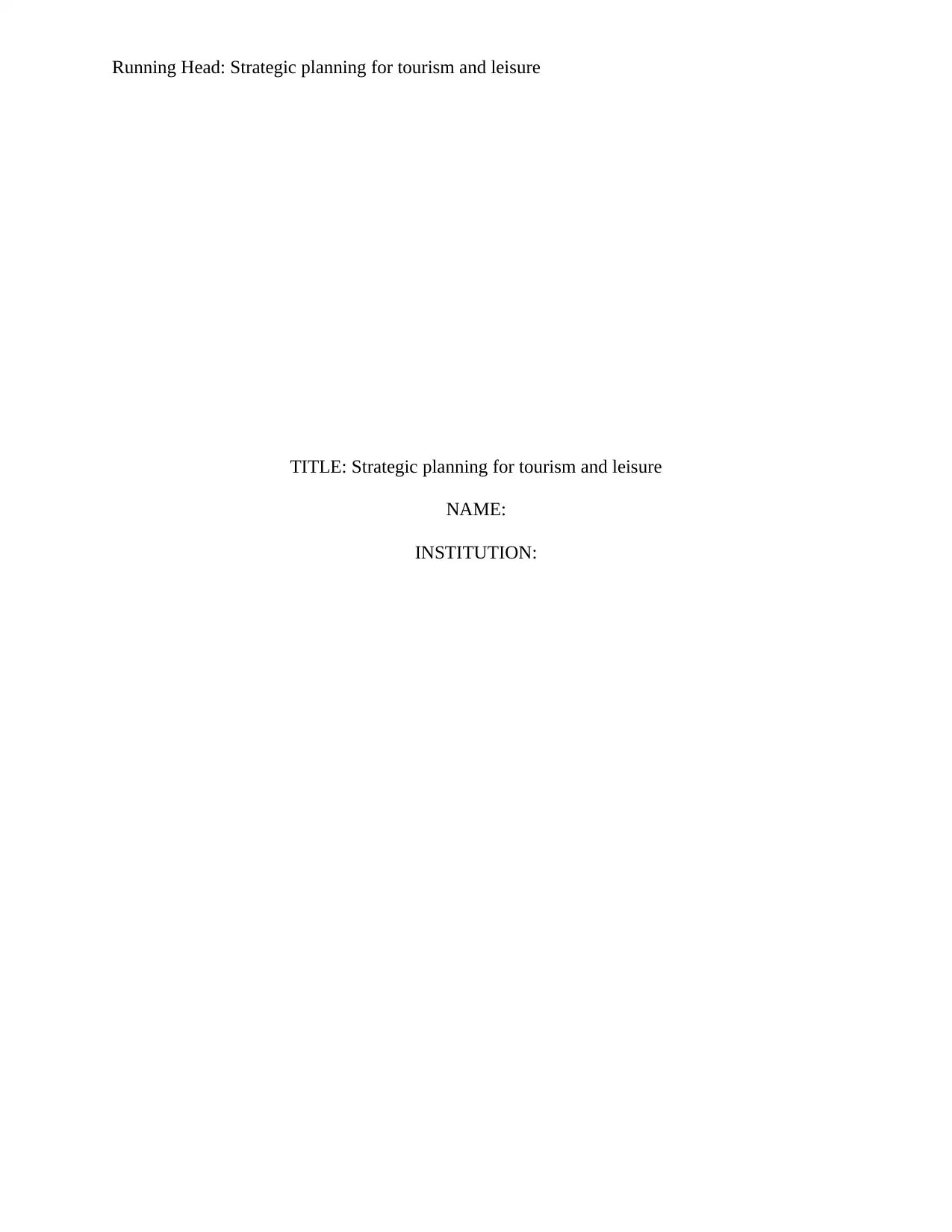
Running Head: Strategic planning for tourism and leisure
TITLE: Strategic planning for tourism and leisure
NAME:
INSTITUTION:
TITLE: Strategic planning for tourism and leisure
NAME:
INSTITUTION:
Paraphrase This Document
Need a fresh take? Get an instant paraphrase of this document with our AI Paraphraser
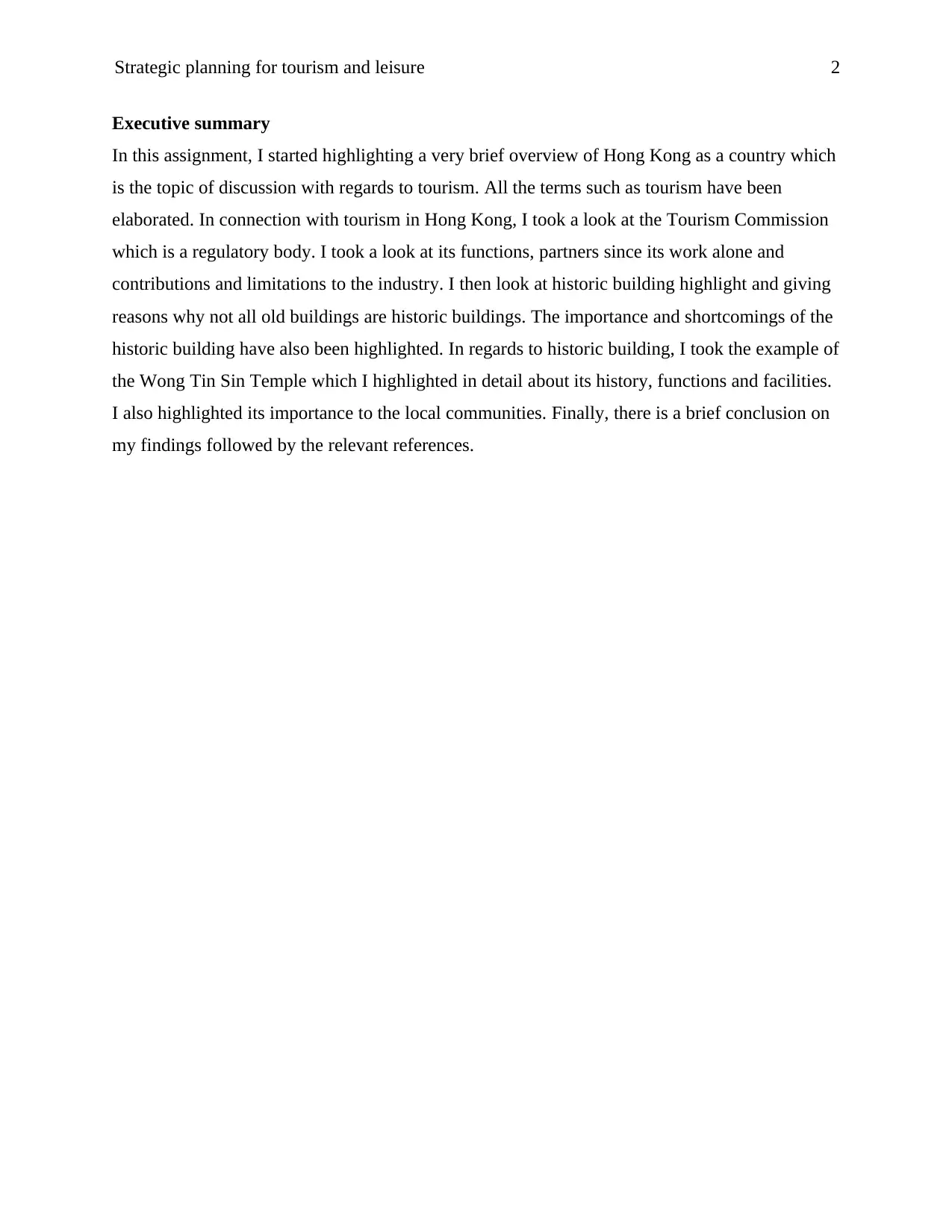
Strategic planning for tourism and leisure 2
Executive summary
In this assignment, I started highlighting a very brief overview of Hong Kong as a country which
is the topic of discussion with regards to tourism. All the terms such as tourism have been
elaborated. In connection with tourism in Hong Kong, I took a look at the Tourism Commission
which is a regulatory body. I took a look at its functions, partners since its work alone and
contributions and limitations to the industry. I then look at historic building highlight and giving
reasons why not all old buildings are historic buildings. The importance and shortcomings of the
historic building have also been highlighted. In regards to historic building, I took the example of
the Wong Tin Sin Temple which I highlighted in detail about its history, functions and facilities.
I also highlighted its importance to the local communities. Finally, there is a brief conclusion on
my findings followed by the relevant references.
Executive summary
In this assignment, I started highlighting a very brief overview of Hong Kong as a country which
is the topic of discussion with regards to tourism. All the terms such as tourism have been
elaborated. In connection with tourism in Hong Kong, I took a look at the Tourism Commission
which is a regulatory body. I took a look at its functions, partners since its work alone and
contributions and limitations to the industry. I then look at historic building highlight and giving
reasons why not all old buildings are historic buildings. The importance and shortcomings of the
historic building have also been highlighted. In regards to historic building, I took the example of
the Wong Tin Sin Temple which I highlighted in detail about its history, functions and facilities.
I also highlighted its importance to the local communities. Finally, there is a brief conclusion on
my findings followed by the relevant references.
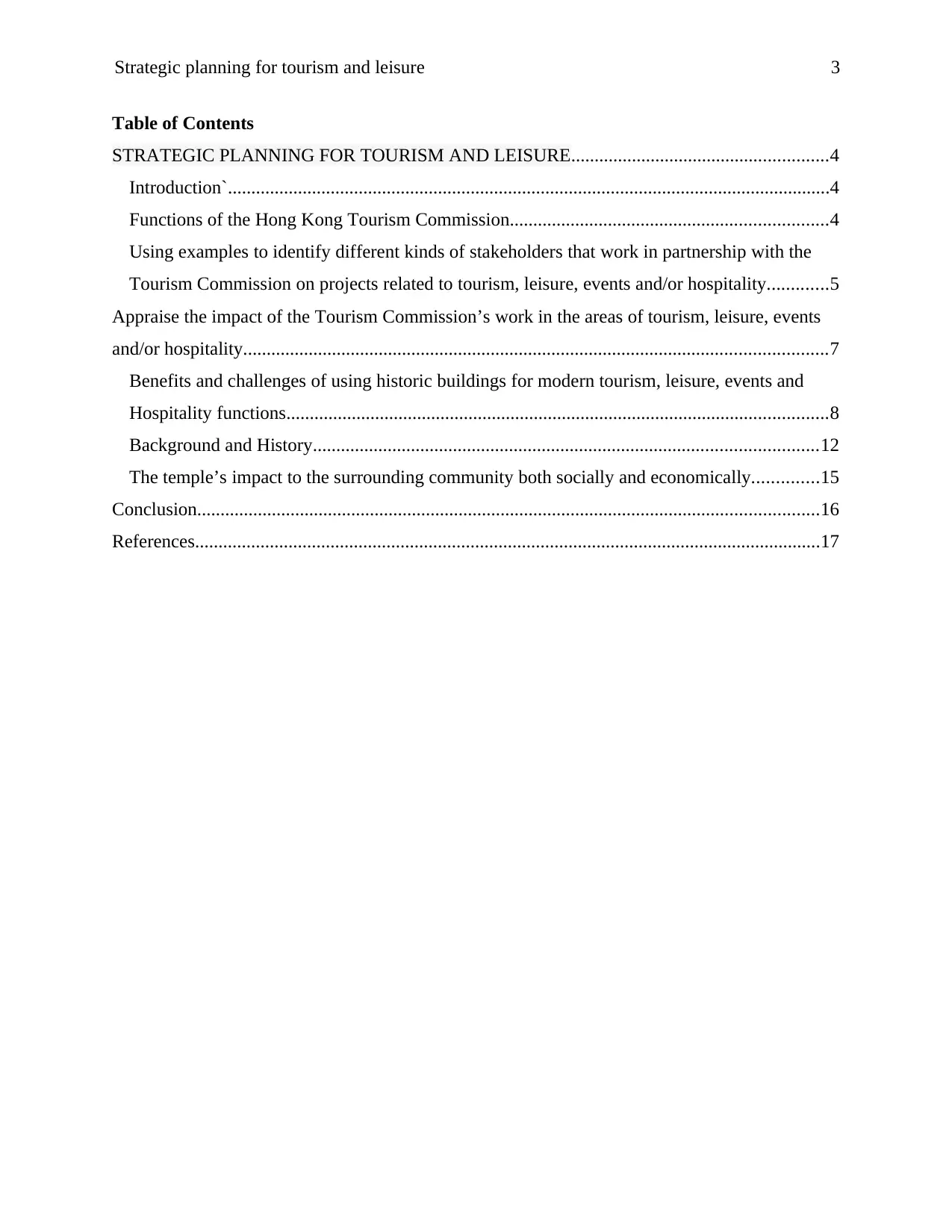
Strategic planning for tourism and leisure 3
Table of Contents
STRATEGIC PLANNING FOR TOURISM AND LEISURE.......................................................4
Introduction`.................................................................................................................................4
Functions of the Hong Kong Tourism Commission....................................................................4
Using examples to identify different kinds of stakeholders that work in partnership with the
Tourism Commission on projects related to tourism, leisure, events and/or hospitality.............5
Appraise the impact of the Tourism Commission’s work in the areas of tourism, leisure, events
and/or hospitality.............................................................................................................................7
Benefits and challenges of using historic buildings for modern tourism, leisure, events and
Hospitality functions....................................................................................................................8
Background and History............................................................................................................12
The temple’s impact to the surrounding community both socially and economically..............15
Conclusion.....................................................................................................................................16
References......................................................................................................................................17
Table of Contents
STRATEGIC PLANNING FOR TOURISM AND LEISURE.......................................................4
Introduction`.................................................................................................................................4
Functions of the Hong Kong Tourism Commission....................................................................4
Using examples to identify different kinds of stakeholders that work in partnership with the
Tourism Commission on projects related to tourism, leisure, events and/or hospitality.............5
Appraise the impact of the Tourism Commission’s work in the areas of tourism, leisure, events
and/or hospitality.............................................................................................................................7
Benefits and challenges of using historic buildings for modern tourism, leisure, events and
Hospitality functions....................................................................................................................8
Background and History............................................................................................................12
The temple’s impact to the surrounding community both socially and economically..............15
Conclusion.....................................................................................................................................16
References......................................................................................................................................17
⊘ This is a preview!⊘
Do you want full access?
Subscribe today to unlock all pages.

Trusted by 1+ million students worldwide
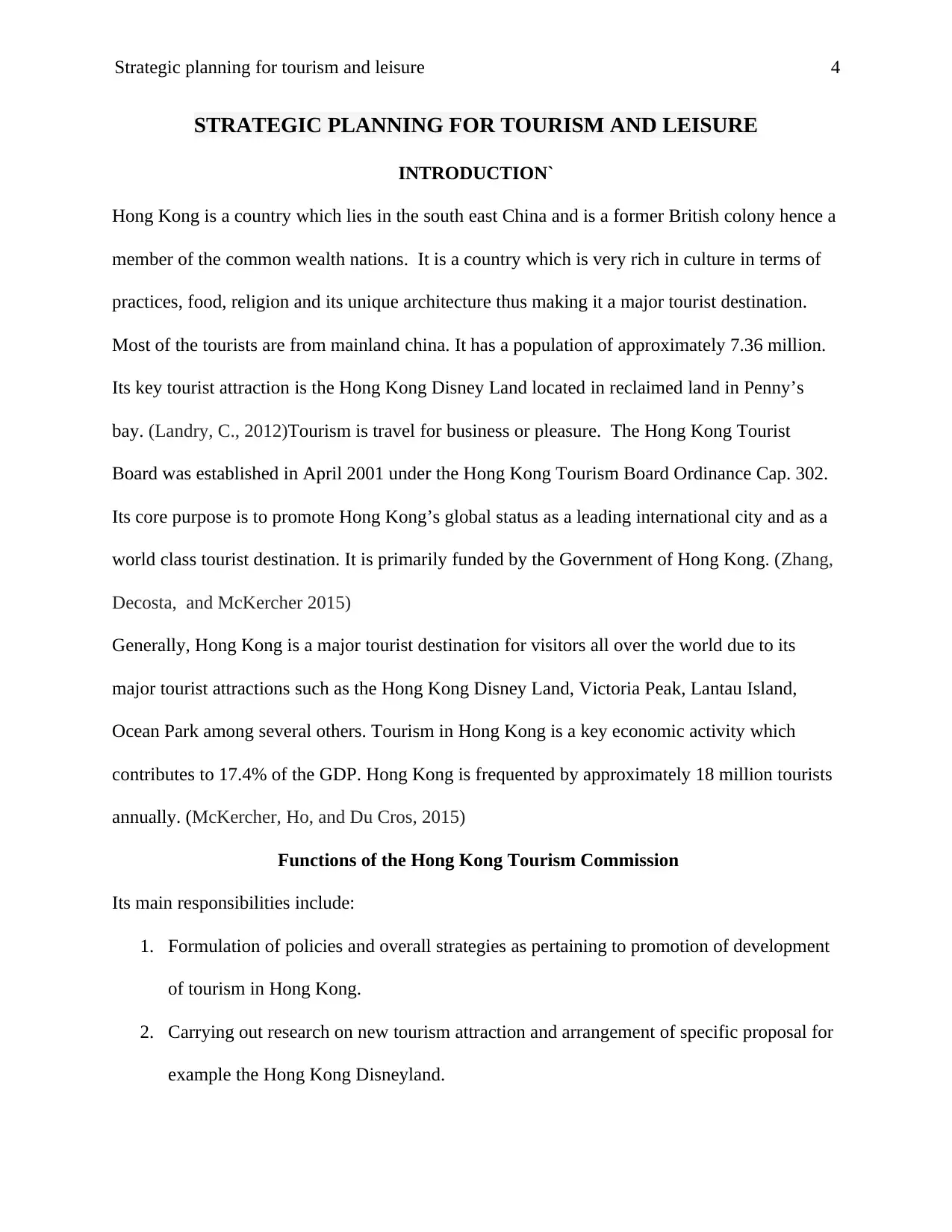
Strategic planning for tourism and leisure 4
STRATEGIC PLANNING FOR TOURISM AND LEISURE
INTRODUCTION`
Hong Kong is a country which lies in the south east China and is a former British colony hence a
member of the common wealth nations. It is a country which is very rich in culture in terms of
practices, food, religion and its unique architecture thus making it a major tourist destination.
Most of the tourists are from mainland china. It has a population of approximately 7.36 million.
Its key tourist attraction is the Hong Kong Disney Land located in reclaimed land in Penny’s
bay. (Landry, C., 2012)Tourism is travel for business or pleasure. The Hong Kong Tourist
Board was established in April 2001 under the Hong Kong Tourism Board Ordinance Cap. 302.
Its core purpose is to promote Hong Kong’s global status as a leading international city and as a
world class tourist destination. It is primarily funded by the Government of Hong Kong. (Zhang,
Decosta, and McKercher 2015)
Generally, Hong Kong is a major tourist destination for visitors all over the world due to its
major tourist attractions such as the Hong Kong Disney Land, Victoria Peak, Lantau Island,
Ocean Park among several others. Tourism in Hong Kong is a key economic activity which
contributes to 17.4% of the GDP. Hong Kong is frequented by approximately 18 million tourists
annually. (McKercher, Ho, and Du Cros, 2015)
Functions of the Hong Kong Tourism Commission
Its main responsibilities include:
1. Formulation of policies and overall strategies as pertaining to promotion of development
of tourism in Hong Kong.
2. Carrying out research on new tourism attraction and arrangement of specific proposal for
example the Hong Kong Disneyland.
STRATEGIC PLANNING FOR TOURISM AND LEISURE
INTRODUCTION`
Hong Kong is a country which lies in the south east China and is a former British colony hence a
member of the common wealth nations. It is a country which is very rich in culture in terms of
practices, food, religion and its unique architecture thus making it a major tourist destination.
Most of the tourists are from mainland china. It has a population of approximately 7.36 million.
Its key tourist attraction is the Hong Kong Disney Land located in reclaimed land in Penny’s
bay. (Landry, C., 2012)Tourism is travel for business or pleasure. The Hong Kong Tourist
Board was established in April 2001 under the Hong Kong Tourism Board Ordinance Cap. 302.
Its core purpose is to promote Hong Kong’s global status as a leading international city and as a
world class tourist destination. It is primarily funded by the Government of Hong Kong. (Zhang,
Decosta, and McKercher 2015)
Generally, Hong Kong is a major tourist destination for visitors all over the world due to its
major tourist attractions such as the Hong Kong Disney Land, Victoria Peak, Lantau Island,
Ocean Park among several others. Tourism in Hong Kong is a key economic activity which
contributes to 17.4% of the GDP. Hong Kong is frequented by approximately 18 million tourists
annually. (McKercher, Ho, and Du Cros, 2015)
Functions of the Hong Kong Tourism Commission
Its main responsibilities include:
1. Formulation of policies and overall strategies as pertaining to promotion of development
of tourism in Hong Kong.
2. Carrying out research on new tourism attraction and arrangement of specific proposal for
example the Hong Kong Disneyland.
Paraphrase This Document
Need a fresh take? Get an instant paraphrase of this document with our AI Paraphraser
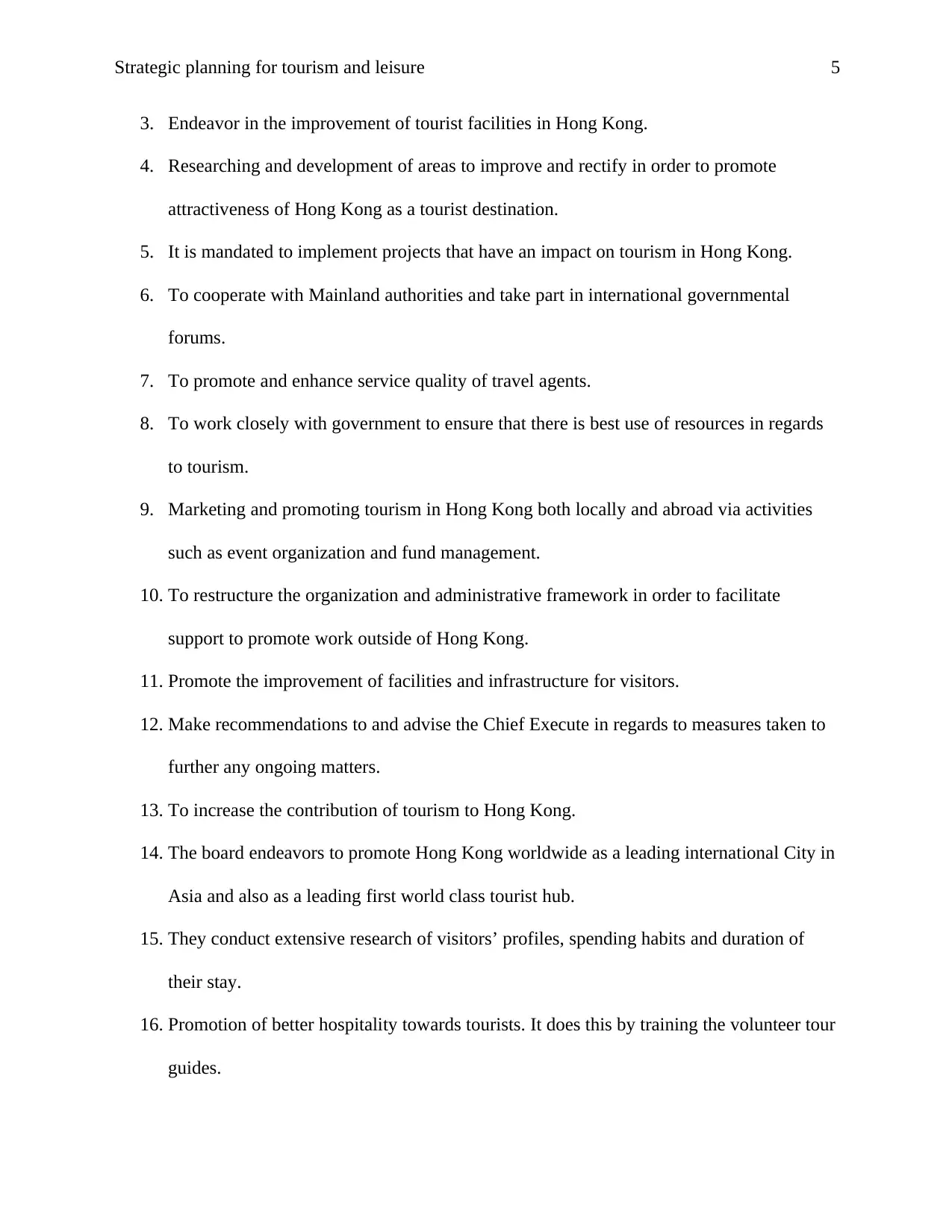
Strategic planning for tourism and leisure 5
3. Endeavor in the improvement of tourist facilities in Hong Kong.
4. Researching and development of areas to improve and rectify in order to promote
attractiveness of Hong Kong as a tourist destination.
5. It is mandated to implement projects that have an impact on tourism in Hong Kong.
6. To cooperate with Mainland authorities and take part in international governmental
forums.
7. To promote and enhance service quality of travel agents.
8. To work closely with government to ensure that there is best use of resources in regards
to tourism.
9. Marketing and promoting tourism in Hong Kong both locally and abroad via activities
such as event organization and fund management.
10. To restructure the organization and administrative framework in order to facilitate
support to promote work outside of Hong Kong.
11. Promote the improvement of facilities and infrastructure for visitors.
12. Make recommendations to and advise the Chief Execute in regards to measures taken to
further any ongoing matters.
13. To increase the contribution of tourism to Hong Kong.
14. The board endeavors to promote Hong Kong worldwide as a leading international City in
Asia and also as a leading first world class tourist hub.
15. They conduct extensive research of visitors’ profiles, spending habits and duration of
their stay.
16. Promotion of better hospitality towards tourists. It does this by training the volunteer tour
guides.
3. Endeavor in the improvement of tourist facilities in Hong Kong.
4. Researching and development of areas to improve and rectify in order to promote
attractiveness of Hong Kong as a tourist destination.
5. It is mandated to implement projects that have an impact on tourism in Hong Kong.
6. To cooperate with Mainland authorities and take part in international governmental
forums.
7. To promote and enhance service quality of travel agents.
8. To work closely with government to ensure that there is best use of resources in regards
to tourism.
9. Marketing and promoting tourism in Hong Kong both locally and abroad via activities
such as event organization and fund management.
10. To restructure the organization and administrative framework in order to facilitate
support to promote work outside of Hong Kong.
11. Promote the improvement of facilities and infrastructure for visitors.
12. Make recommendations to and advise the Chief Execute in regards to measures taken to
further any ongoing matters.
13. To increase the contribution of tourism to Hong Kong.
14. The board endeavors to promote Hong Kong worldwide as a leading international City in
Asia and also as a leading first world class tourist hub.
15. They conduct extensive research of visitors’ profiles, spending habits and duration of
their stay.
16. Promotion of better hospitality towards tourists. It does this by training the volunteer tour
guides.
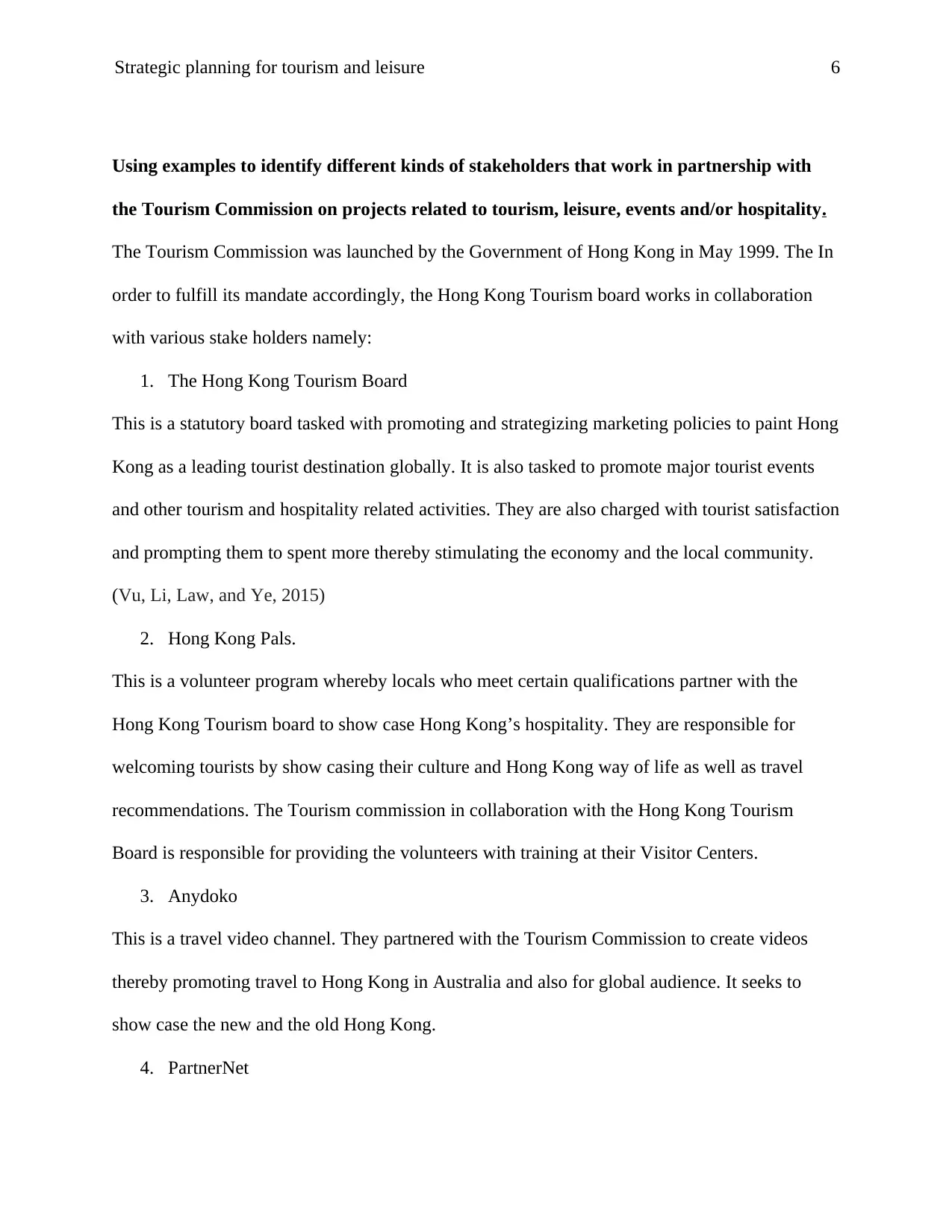
Strategic planning for tourism and leisure 6
Using examples to identify different kinds of stakeholders that work in partnership with
the Tourism Commission on projects related to tourism, leisure, events and/or hospitality.
The Tourism Commission was launched by the Government of Hong Kong in May 1999. The In
order to fulfill its mandate accordingly, the Hong Kong Tourism board works in collaboration
with various stake holders namely:
1. The Hong Kong Tourism Board
This is a statutory board tasked with promoting and strategizing marketing policies to paint Hong
Kong as a leading tourist destination globally. It is also tasked to promote major tourist events
and other tourism and hospitality related activities. They are also charged with tourist satisfaction
and prompting them to spent more thereby stimulating the economy and the local community.
(Vu, Li, Law, and Ye, 2015)
2. Hong Kong Pals.
This is a volunteer program whereby locals who meet certain qualifications partner with the
Hong Kong Tourism board to show case Hong Kong’s hospitality. They are responsible for
welcoming tourists by show casing their culture and Hong Kong way of life as well as travel
recommendations. The Tourism commission in collaboration with the Hong Kong Tourism
Board is responsible for providing the volunteers with training at their Visitor Centers.
3. Anydoko
This is a travel video channel. They partnered with the Tourism Commission to create videos
thereby promoting travel to Hong Kong in Australia and also for global audience. It seeks to
show case the new and the old Hong Kong.
4. PartnerNet
Using examples to identify different kinds of stakeholders that work in partnership with
the Tourism Commission on projects related to tourism, leisure, events and/or hospitality.
The Tourism Commission was launched by the Government of Hong Kong in May 1999. The In
order to fulfill its mandate accordingly, the Hong Kong Tourism board works in collaboration
with various stake holders namely:
1. The Hong Kong Tourism Board
This is a statutory board tasked with promoting and strategizing marketing policies to paint Hong
Kong as a leading tourist destination globally. It is also tasked to promote major tourist events
and other tourism and hospitality related activities. They are also charged with tourist satisfaction
and prompting them to spent more thereby stimulating the economy and the local community.
(Vu, Li, Law, and Ye, 2015)
2. Hong Kong Pals.
This is a volunteer program whereby locals who meet certain qualifications partner with the
Hong Kong Tourism board to show case Hong Kong’s hospitality. They are responsible for
welcoming tourists by show casing their culture and Hong Kong way of life as well as travel
recommendations. The Tourism commission in collaboration with the Hong Kong Tourism
Board is responsible for providing the volunteers with training at their Visitor Centers.
3. Anydoko
This is a travel video channel. They partnered with the Tourism Commission to create videos
thereby promoting travel to Hong Kong in Australia and also for global audience. It seeks to
show case the new and the old Hong Kong.
4. PartnerNet
⊘ This is a preview!⊘
Do you want full access?
Subscribe today to unlock all pages.

Trusted by 1+ million students worldwide
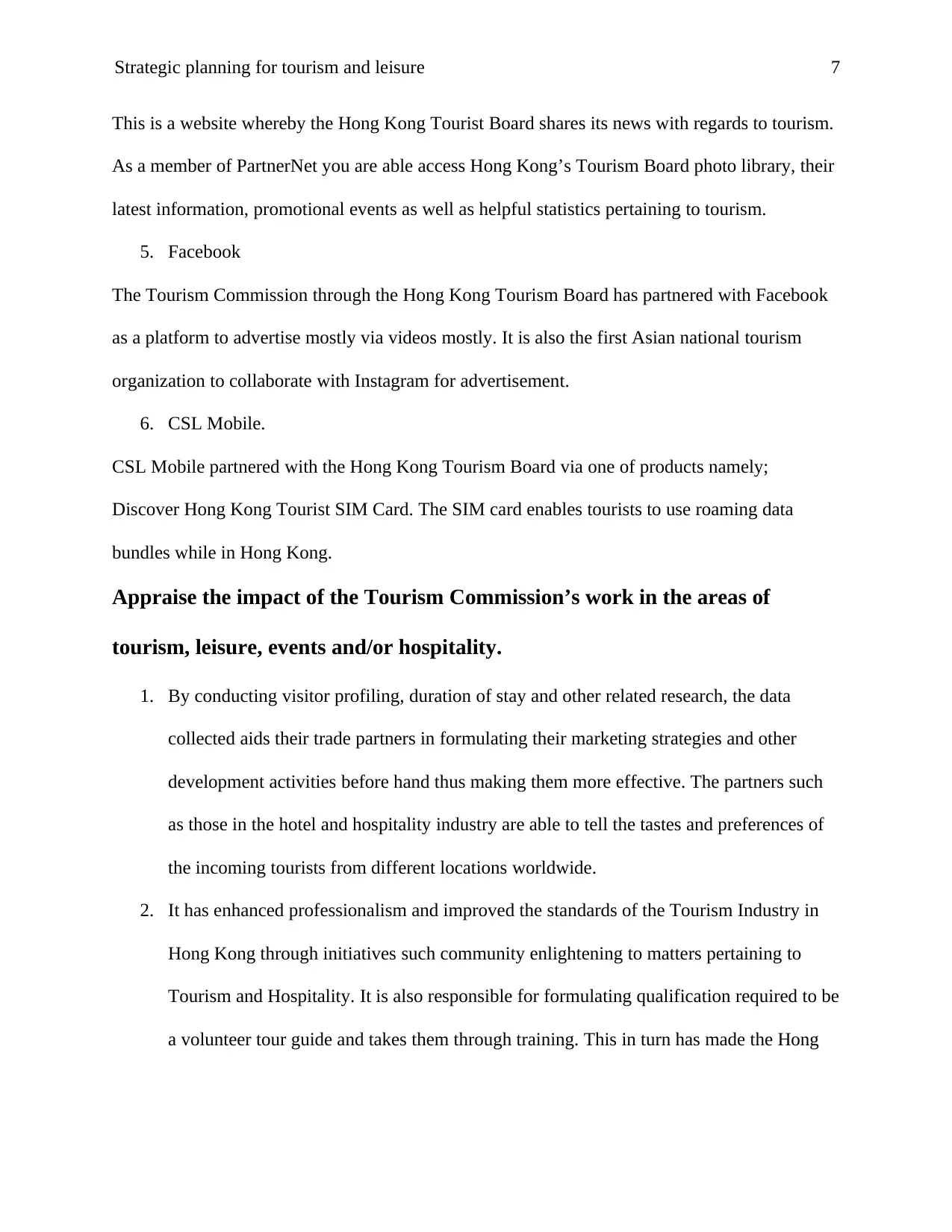
Strategic planning for tourism and leisure 7
This is a website whereby the Hong Kong Tourist Board shares its news with regards to tourism.
As a member of PartnerNet you are able access Hong Kong’s Tourism Board photo library, their
latest information, promotional events as well as helpful statistics pertaining to tourism.
5. Facebook
The Tourism Commission through the Hong Kong Tourism Board has partnered with Facebook
as a platform to advertise mostly via videos mostly. It is also the first Asian national tourism
organization to collaborate with Instagram for advertisement.
6. CSL Mobile.
CSL Mobile partnered with the Hong Kong Tourism Board via one of products namely;
Discover Hong Kong Tourist SIM Card. The SIM card enables tourists to use roaming data
bundles while in Hong Kong.
Appraise the impact of the Tourism Commission’s work in the areas of
tourism, leisure, events and/or hospitality.
1. By conducting visitor profiling, duration of stay and other related research, the data
collected aids their trade partners in formulating their marketing strategies and other
development activities before hand thus making them more effective. The partners such
as those in the hotel and hospitality industry are able to tell the tastes and preferences of
the incoming tourists from different locations worldwide.
2. It has enhanced professionalism and improved the standards of the Tourism Industry in
Hong Kong through initiatives such community enlightening to matters pertaining to
Tourism and Hospitality. It is also responsible for formulating qualification required to be
a volunteer tour guide and takes them through training. This in turn has made the Hong
This is a website whereby the Hong Kong Tourist Board shares its news with regards to tourism.
As a member of PartnerNet you are able access Hong Kong’s Tourism Board photo library, their
latest information, promotional events as well as helpful statistics pertaining to tourism.
5. Facebook
The Tourism Commission through the Hong Kong Tourism Board has partnered with Facebook
as a platform to advertise mostly via videos mostly. It is also the first Asian national tourism
organization to collaborate with Instagram for advertisement.
6. CSL Mobile.
CSL Mobile partnered with the Hong Kong Tourism Board via one of products namely;
Discover Hong Kong Tourist SIM Card. The SIM card enables tourists to use roaming data
bundles while in Hong Kong.
Appraise the impact of the Tourism Commission’s work in the areas of
tourism, leisure, events and/or hospitality.
1. By conducting visitor profiling, duration of stay and other related research, the data
collected aids their trade partners in formulating their marketing strategies and other
development activities before hand thus making them more effective. The partners such
as those in the hotel and hospitality industry are able to tell the tastes and preferences of
the incoming tourists from different locations worldwide.
2. It has enhanced professionalism and improved the standards of the Tourism Industry in
Hong Kong through initiatives such community enlightening to matters pertaining to
Tourism and Hospitality. It is also responsible for formulating qualification required to be
a volunteer tour guide and takes them through training. This in turn has made the Hong
Paraphrase This Document
Need a fresh take? Get an instant paraphrase of this document with our AI Paraphraser
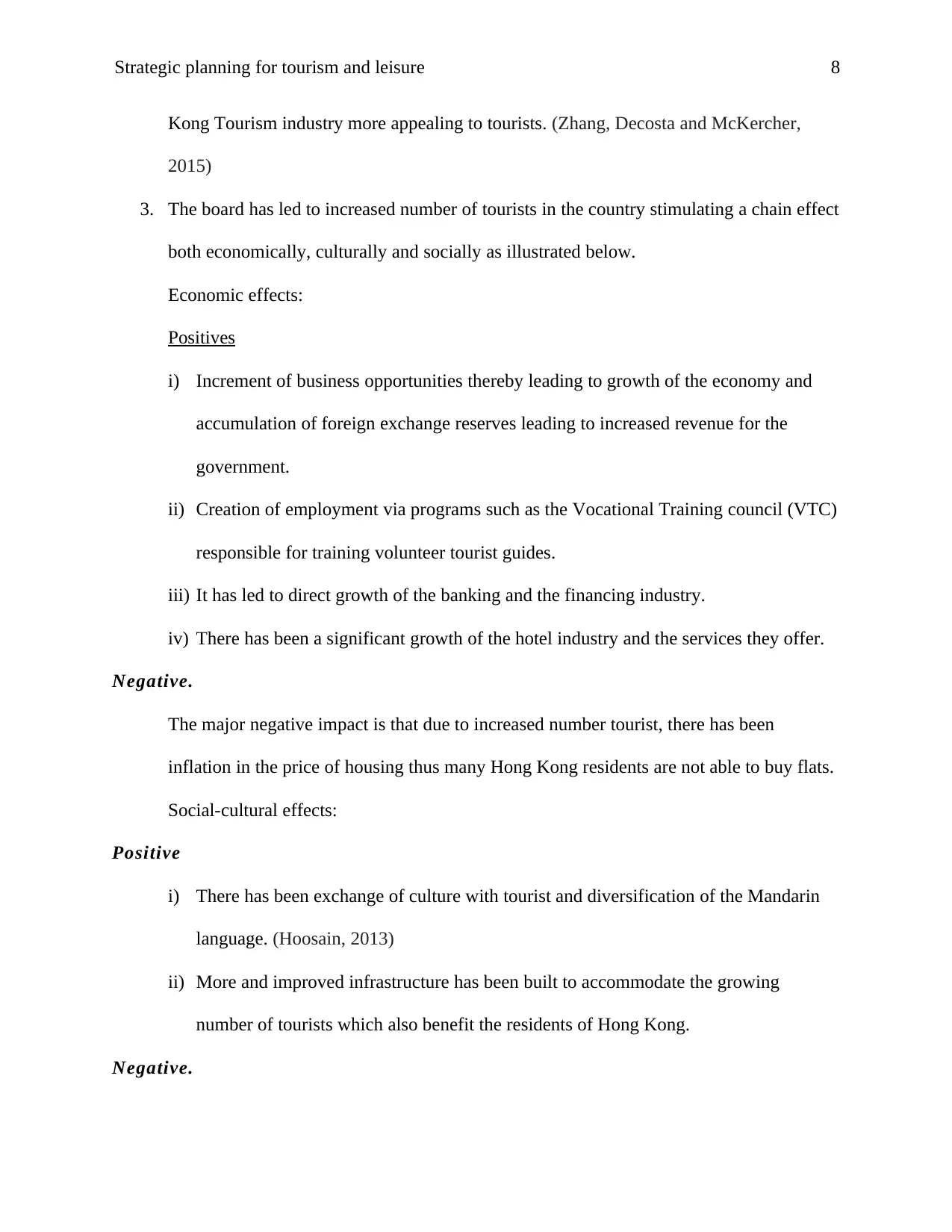
Strategic planning for tourism and leisure 8
Kong Tourism industry more appealing to tourists. (Zhang, Decosta and McKercher,
2015)
3. The board has led to increased number of tourists in the country stimulating a chain effect
both economically, culturally and socially as illustrated below.
Economic effects:
Positives
i) Increment of business opportunities thereby leading to growth of the economy and
accumulation of foreign exchange reserves leading to increased revenue for the
government.
ii) Creation of employment via programs such as the Vocational Training council (VTC)
responsible for training volunteer tourist guides.
iii) It has led to direct growth of the banking and the financing industry.
iv) There has been a significant growth of the hotel industry and the services they offer.
Negative.
The major negative impact is that due to increased number tourist, there has been
inflation in the price of housing thus many Hong Kong residents are not able to buy flats.
Social-cultural effects:
Positive
i) There has been exchange of culture with tourist and diversification of the Mandarin
language. (Hoosain, 2013)
ii) More and improved infrastructure has been built to accommodate the growing
number of tourists which also benefit the residents of Hong Kong.
Negative.
Kong Tourism industry more appealing to tourists. (Zhang, Decosta and McKercher,
2015)
3. The board has led to increased number of tourists in the country stimulating a chain effect
both economically, culturally and socially as illustrated below.
Economic effects:
Positives
i) Increment of business opportunities thereby leading to growth of the economy and
accumulation of foreign exchange reserves leading to increased revenue for the
government.
ii) Creation of employment via programs such as the Vocational Training council (VTC)
responsible for training volunteer tourist guides.
iii) It has led to direct growth of the banking and the financing industry.
iv) There has been a significant growth of the hotel industry and the services they offer.
Negative.
The major negative impact is that due to increased number tourist, there has been
inflation in the price of housing thus many Hong Kong residents are not able to buy flats.
Social-cultural effects:
Positive
i) There has been exchange of culture with tourist and diversification of the Mandarin
language. (Hoosain, 2013)
ii) More and improved infrastructure has been built to accommodate the growing
number of tourists which also benefit the residents of Hong Kong.
Negative.
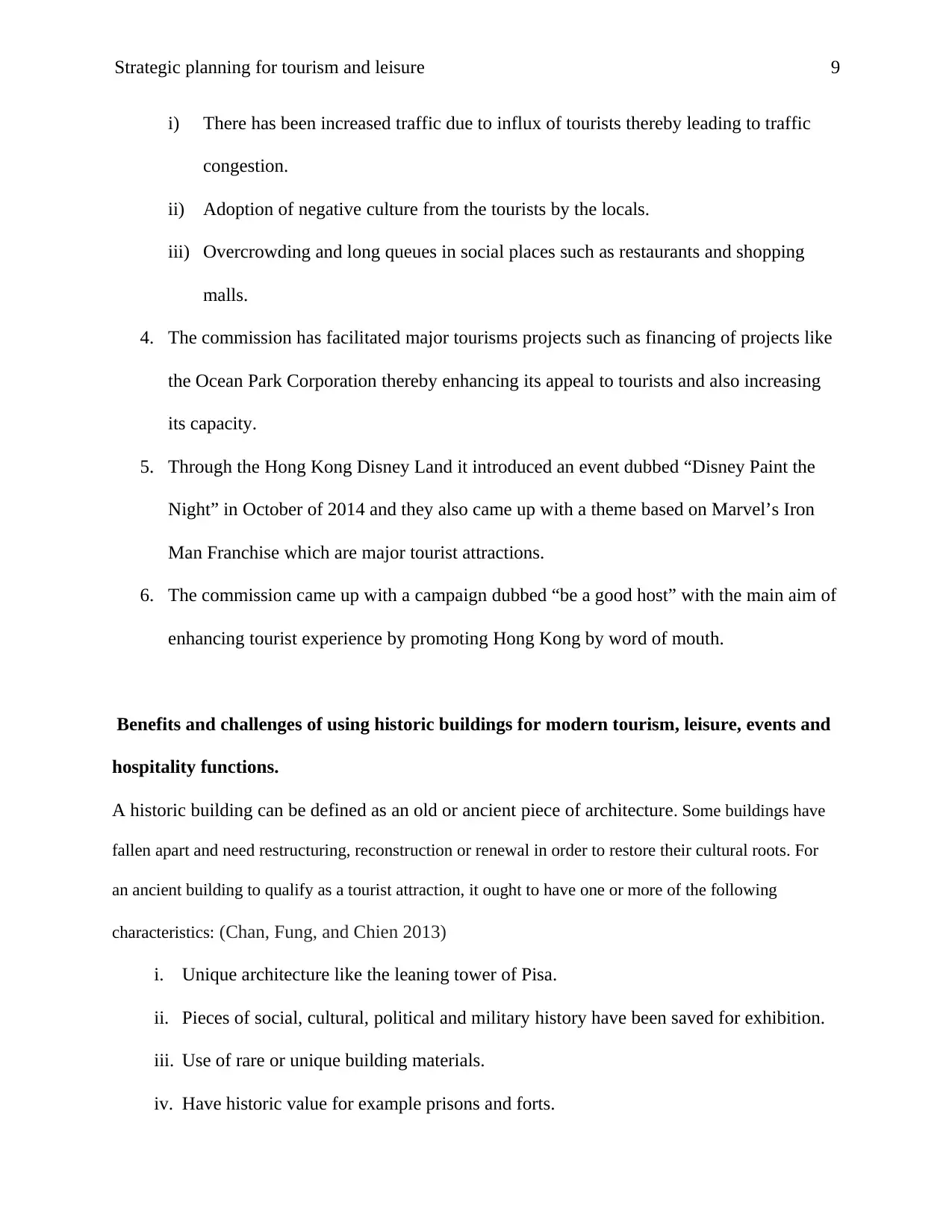
Strategic planning for tourism and leisure 9
i) There has been increased traffic due to influx of tourists thereby leading to traffic
congestion.
ii) Adoption of negative culture from the tourists by the locals.
iii) Overcrowding and long queues in social places such as restaurants and shopping
malls.
4. The commission has facilitated major tourisms projects such as financing of projects like
the Ocean Park Corporation thereby enhancing its appeal to tourists and also increasing
its capacity.
5. Through the Hong Kong Disney Land it introduced an event dubbed “Disney Paint the
Night” in October of 2014 and they also came up with a theme based on Marvel’s Iron
Man Franchise which are major tourist attractions.
6. The commission came up with a campaign dubbed “be a good host” with the main aim of
enhancing tourist experience by promoting Hong Kong by word of mouth.
Benefits and challenges of using historic buildings for modern tourism, leisure, events and
hospitality functions.
A historic building can be defined as an old or ancient piece of architecture. Some buildings have
fallen apart and need restructuring, reconstruction or renewal in order to restore their cultural roots. For
an ancient building to qualify as a tourist attraction, it ought to have one or more of the following
characteristics: (Chan, Fung, and Chien 2013)
i. Unique architecture like the leaning tower of Pisa.
ii. Pieces of social, cultural, political and military history have been saved for exhibition.
iii. Use of rare or unique building materials.
iv. Have historic value for example prisons and forts.
i) There has been increased traffic due to influx of tourists thereby leading to traffic
congestion.
ii) Adoption of negative culture from the tourists by the locals.
iii) Overcrowding and long queues in social places such as restaurants and shopping
malls.
4. The commission has facilitated major tourisms projects such as financing of projects like
the Ocean Park Corporation thereby enhancing its appeal to tourists and also increasing
its capacity.
5. Through the Hong Kong Disney Land it introduced an event dubbed “Disney Paint the
Night” in October of 2014 and they also came up with a theme based on Marvel’s Iron
Man Franchise which are major tourist attractions.
6. The commission came up with a campaign dubbed “be a good host” with the main aim of
enhancing tourist experience by promoting Hong Kong by word of mouth.
Benefits and challenges of using historic buildings for modern tourism, leisure, events and
hospitality functions.
A historic building can be defined as an old or ancient piece of architecture. Some buildings have
fallen apart and need restructuring, reconstruction or renewal in order to restore their cultural roots. For
an ancient building to qualify as a tourist attraction, it ought to have one or more of the following
characteristics: (Chan, Fung, and Chien 2013)
i. Unique architecture like the leaning tower of Pisa.
ii. Pieces of social, cultural, political and military history have been saved for exhibition.
iii. Use of rare or unique building materials.
iv. Have historic value for example prisons and forts.
⊘ This is a preview!⊘
Do you want full access?
Subscribe today to unlock all pages.

Trusted by 1+ million students worldwide
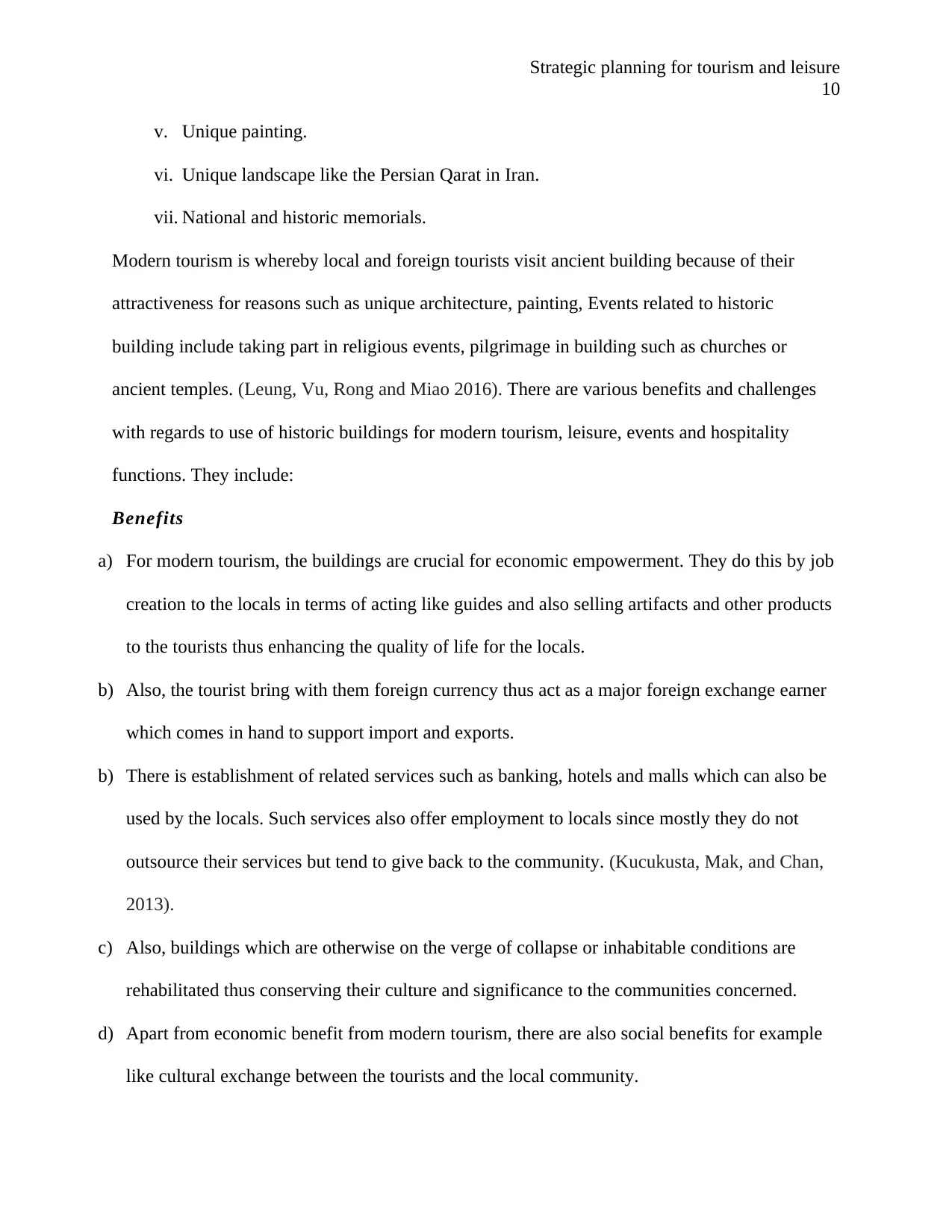
Strategic planning for tourism and leisure
10
v. Unique painting.
vi. Unique landscape like the Persian Qarat in Iran.
vii. National and historic memorials.
Modern tourism is whereby local and foreign tourists visit ancient building because of their
attractiveness for reasons such as unique architecture, painting, Events related to historic
building include taking part in religious events, pilgrimage in building such as churches or
ancient temples. (Leung, Vu, Rong and Miao 2016). There are various benefits and challenges
with regards to use of historic buildings for modern tourism, leisure, events and hospitality
functions. They include:
Benefits
a) For modern tourism, the buildings are crucial for economic empowerment. They do this by job
creation to the locals in terms of acting like guides and also selling artifacts and other products
to the tourists thus enhancing the quality of life for the locals.
b) Also, the tourist bring with them foreign currency thus act as a major foreign exchange earner
which comes in hand to support import and exports.
b) There is establishment of related services such as banking, hotels and malls which can also be
used by the locals. Such services also offer employment to locals since mostly they do not
outsource their services but tend to give back to the community. (Kucukusta, Mak, and Chan,
2013).
c) Also, buildings which are otherwise on the verge of collapse or inhabitable conditions are
rehabilitated thus conserving their culture and significance to the communities concerned.
d) Apart from economic benefit from modern tourism, there are also social benefits for example
like cultural exchange between the tourists and the local community.
10
v. Unique painting.
vi. Unique landscape like the Persian Qarat in Iran.
vii. National and historic memorials.
Modern tourism is whereby local and foreign tourists visit ancient building because of their
attractiveness for reasons such as unique architecture, painting, Events related to historic
building include taking part in religious events, pilgrimage in building such as churches or
ancient temples. (Leung, Vu, Rong and Miao 2016). There are various benefits and challenges
with regards to use of historic buildings for modern tourism, leisure, events and hospitality
functions. They include:
Benefits
a) For modern tourism, the buildings are crucial for economic empowerment. They do this by job
creation to the locals in terms of acting like guides and also selling artifacts and other products
to the tourists thus enhancing the quality of life for the locals.
b) Also, the tourist bring with them foreign currency thus act as a major foreign exchange earner
which comes in hand to support import and exports.
b) There is establishment of related services such as banking, hotels and malls which can also be
used by the locals. Such services also offer employment to locals since mostly they do not
outsource their services but tend to give back to the community. (Kucukusta, Mak, and Chan,
2013).
c) Also, buildings which are otherwise on the verge of collapse or inhabitable conditions are
rehabilitated thus conserving their culture and significance to the communities concerned.
d) Apart from economic benefit from modern tourism, there are also social benefits for example
like cultural exchange between the tourists and the local community.
Paraphrase This Document
Need a fresh take? Get an instant paraphrase of this document with our AI Paraphraser
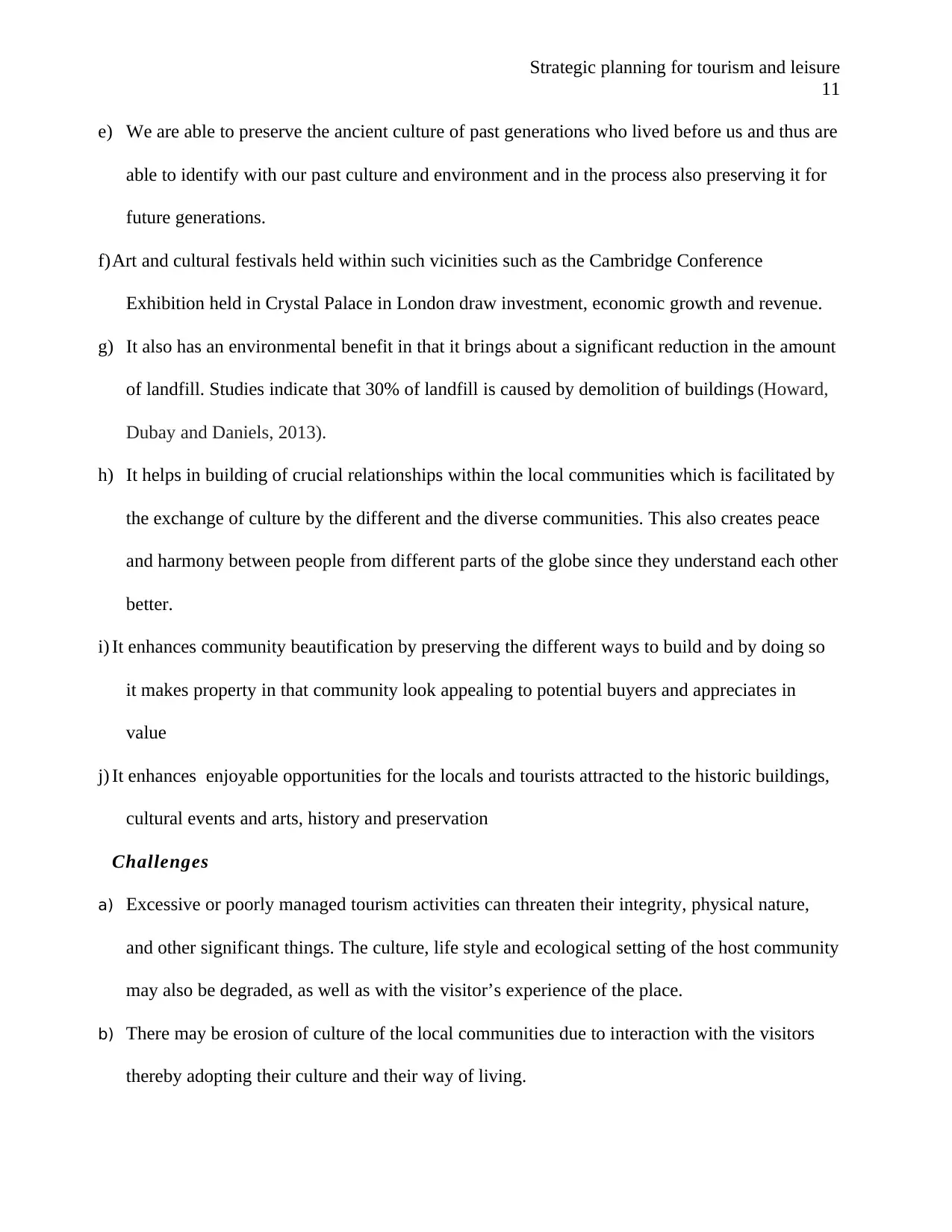
Strategic planning for tourism and leisure
11
e) We are able to preserve the ancient culture of past generations who lived before us and thus are
able to identify with our past culture and environment and in the process also preserving it for
future generations.
f)Art and cultural festivals held within such vicinities such as the Cambridge Conference
Exhibition held in Crystal Palace in London draw investment, economic growth and revenue.
g) It also has an environmental benefit in that it brings about a significant reduction in the amount
of landfill. Studies indicate that 30% of landfill is caused by demolition of buildings (Howard,
Dubay and Daniels, 2013).
h) It helps in building of crucial relationships within the local communities which is facilitated by
the exchange of culture by the different and the diverse communities. This also creates peace
and harmony between people from different parts of the globe since they understand each other
better.
i) It enhances community beautification by preserving the different ways to build and by doing so
it makes property in that community look appealing to potential buyers and appreciates in
value
j) It enhances enjoyable opportunities for the locals and tourists attracted to the historic buildings,
cultural events and arts, history and preservation
Challenges
a) Excessive or poorly managed tourism activities can threaten their integrity, physical nature,
and other significant things. The culture, life style and ecological setting of the host community
may also be degraded, as well as with the visitor’s experience of the place.
b) There may be erosion of culture of the local communities due to interaction with the visitors
thereby adopting their culture and their way of living.
11
e) We are able to preserve the ancient culture of past generations who lived before us and thus are
able to identify with our past culture and environment and in the process also preserving it for
future generations.
f)Art and cultural festivals held within such vicinities such as the Cambridge Conference
Exhibition held in Crystal Palace in London draw investment, economic growth and revenue.
g) It also has an environmental benefit in that it brings about a significant reduction in the amount
of landfill. Studies indicate that 30% of landfill is caused by demolition of buildings (Howard,
Dubay and Daniels, 2013).
h) It helps in building of crucial relationships within the local communities which is facilitated by
the exchange of culture by the different and the diverse communities. This also creates peace
and harmony between people from different parts of the globe since they understand each other
better.
i) It enhances community beautification by preserving the different ways to build and by doing so
it makes property in that community look appealing to potential buyers and appreciates in
value
j) It enhances enjoyable opportunities for the locals and tourists attracted to the historic buildings,
cultural events and arts, history and preservation
Challenges
a) Excessive or poorly managed tourism activities can threaten their integrity, physical nature,
and other significant things. The culture, life style and ecological setting of the host community
may also be degraded, as well as with the visitor’s experience of the place.
b) There may be erosion of culture of the local communities due to interaction with the visitors
thereby adopting their culture and their way of living.
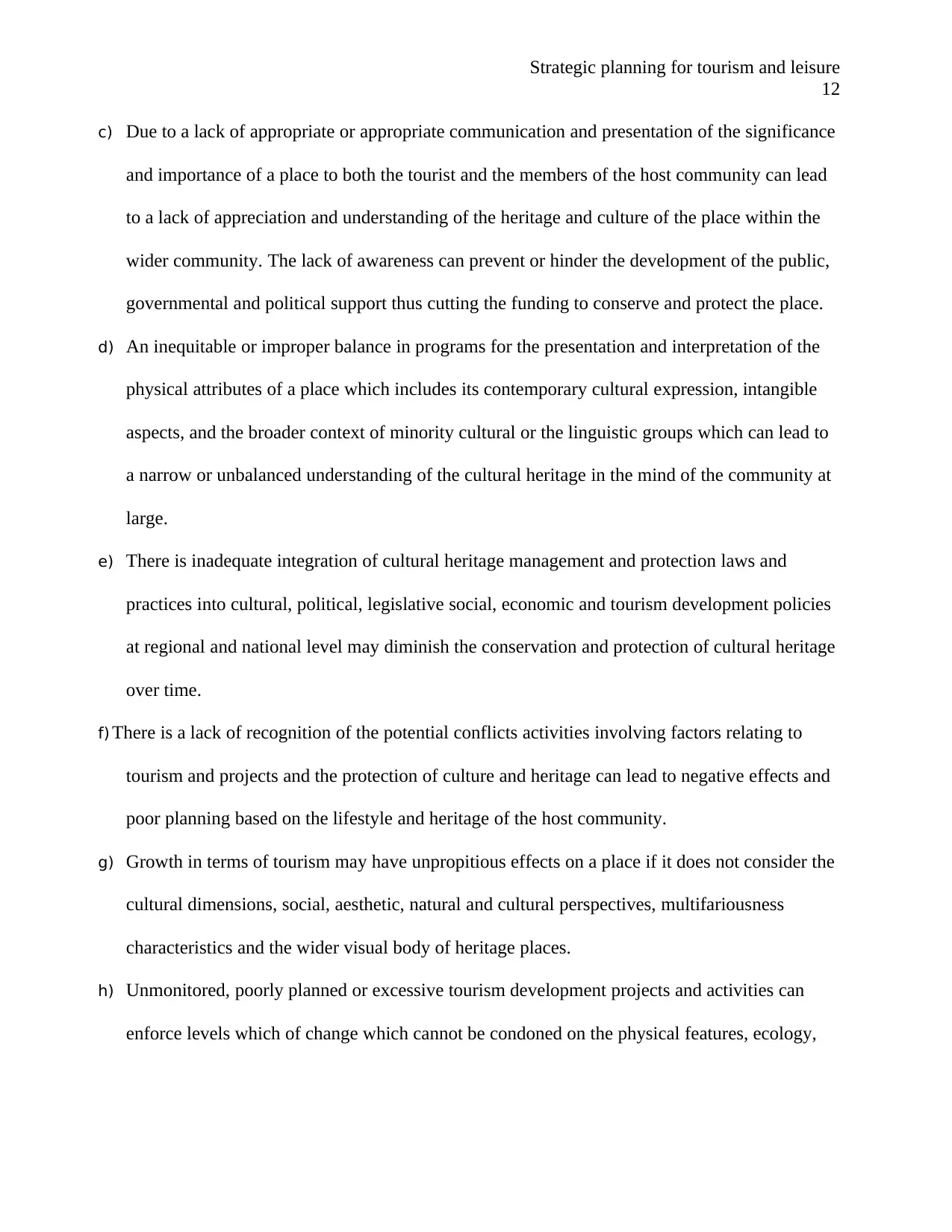
Strategic planning for tourism and leisure
12
c) Due to a lack of appropriate or appropriate communication and presentation of the significance
and importance of a place to both the tourist and the members of the host community can lead
to a lack of appreciation and understanding of the heritage and culture of the place within the
wider community. The lack of awareness can prevent or hinder the development of the public,
governmental and political support thus cutting the funding to conserve and protect the place.
d) An inequitable or improper balance in programs for the presentation and interpretation of the
physical attributes of a place which includes its contemporary cultural expression, intangible
aspects, and the broader context of minority cultural or the linguistic groups which can lead to
a narrow or unbalanced understanding of the cultural heritage in the mind of the community at
large.
e) There is inadequate integration of cultural heritage management and protection laws and
practices into cultural, political, legislative social, economic and tourism development policies
at regional and national level may diminish the conservation and protection of cultural heritage
over time.
f) There is a lack of recognition of the potential conflicts activities involving factors relating to
tourism and projects and the protection of culture and heritage can lead to negative effects and
poor planning based on the lifestyle and heritage of the host community.
g) Growth in terms of tourism may have unpropitious effects on a place if it does not consider the
cultural dimensions, social, aesthetic, natural and cultural perspectives, multifariousness
characteristics and the wider visual body of heritage places.
h) Unmonitored, poorly planned or excessive tourism development projects and activities can
enforce levels which of change which cannot be condoned on the physical features, ecology,
12
c) Due to a lack of appropriate or appropriate communication and presentation of the significance
and importance of a place to both the tourist and the members of the host community can lead
to a lack of appreciation and understanding of the heritage and culture of the place within the
wider community. The lack of awareness can prevent or hinder the development of the public,
governmental and political support thus cutting the funding to conserve and protect the place.
d) An inequitable or improper balance in programs for the presentation and interpretation of the
physical attributes of a place which includes its contemporary cultural expression, intangible
aspects, and the broader context of minority cultural or the linguistic groups which can lead to
a narrow or unbalanced understanding of the cultural heritage in the mind of the community at
large.
e) There is inadequate integration of cultural heritage management and protection laws and
practices into cultural, political, legislative social, economic and tourism development policies
at regional and national level may diminish the conservation and protection of cultural heritage
over time.
f) There is a lack of recognition of the potential conflicts activities involving factors relating to
tourism and projects and the protection of culture and heritage can lead to negative effects and
poor planning based on the lifestyle and heritage of the host community.
g) Growth in terms of tourism may have unpropitious effects on a place if it does not consider the
cultural dimensions, social, aesthetic, natural and cultural perspectives, multifariousness
characteristics and the wider visual body of heritage places.
h) Unmonitored, poorly planned or excessive tourism development projects and activities can
enforce levels which of change which cannot be condoned on the physical features, ecology,
⊘ This is a preview!⊘
Do you want full access?
Subscribe today to unlock all pages.

Trusted by 1+ million students worldwide
1 out of 24
Related Documents
Your All-in-One AI-Powered Toolkit for Academic Success.
+13062052269
info@desklib.com
Available 24*7 on WhatsApp / Email
![[object Object]](/_next/static/media/star-bottom.7253800d.svg)
Unlock your academic potential
Copyright © 2020–2025 A2Z Services. All Rights Reserved. Developed and managed by ZUCOL.





